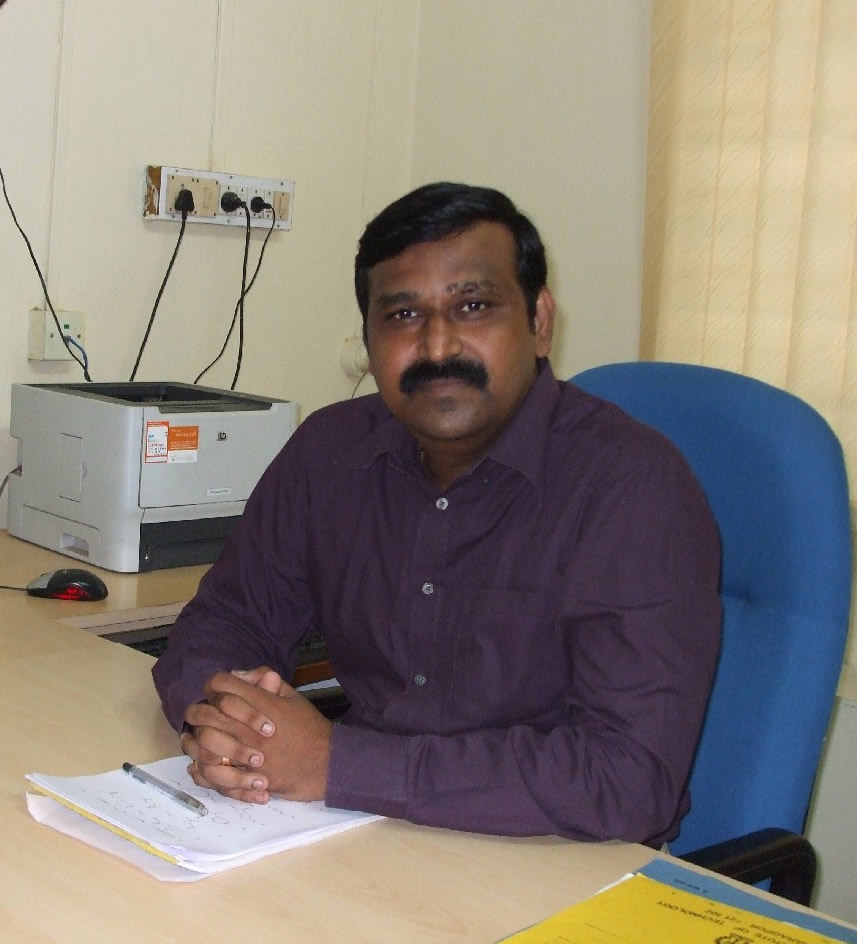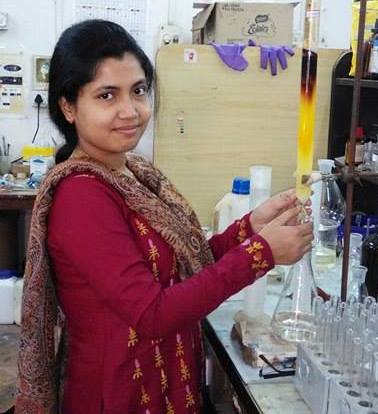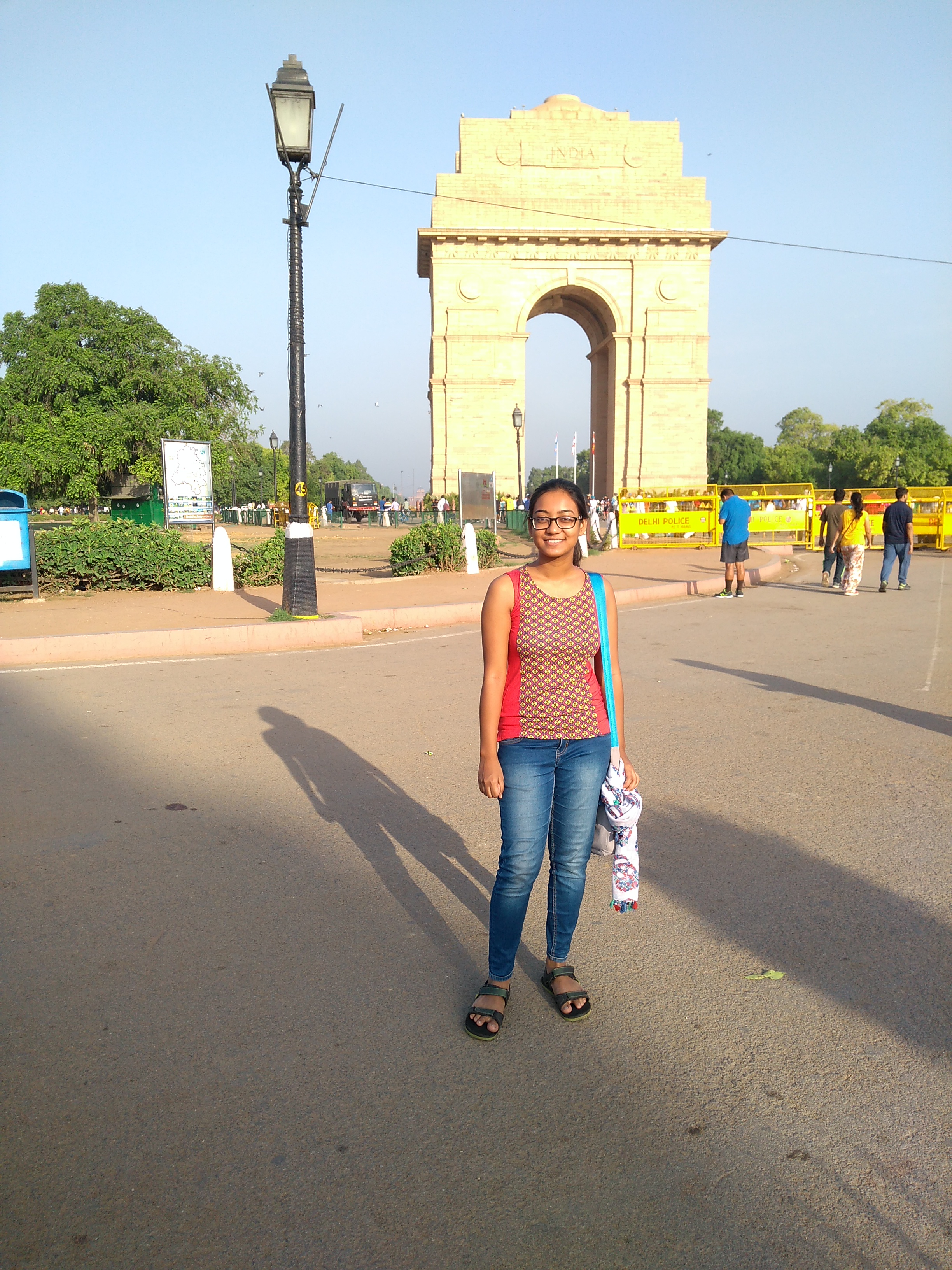Publications
Journal Publications
C. Parthiban, Pavithra. M, Vinod Kumar Reddy. L, Dwaipayan Sen and N. D. Pradeep Singh,"Single-Component Fluorescent Organic Nanoparticles with Four-Armed Phototriggers for Chemo-Photodynamic Therapy and Cellular Imaging" ACS Appl. Nano Mater., 2019
Amrita Paul, Angana Biswas, Sreyashi Sinha, Sk. Sheriff Shah, Manoranjan Bera, Mahitosh Mandal and N. D. Pradeep Singh,"Push-Pull Stilbene: Visible Light Activated Photoremovable Protecting Group for Alcohols and Carboxylic Acids with Fluorescence Reporting Employed for Drug Delivery" Org. Lett., 2019
Yarra Venkatesh, Kumari Shanti Kiran, Sk. Sheriff Shah, Amrita Chaudhuri, Satyahari Dey and N. D. Pradeep Singh,"One- and two-photon responsive sulfur dioxide (SO2) donors: a combinatorial drug delivery for improved antibiotic therapy" Org. Biomol. Chem., 2019
Melvin S.Samuel, Jayanta Bhattacharya, Sankalp Raj, Needhidasan Santhanam, Hemant Singh, N. D. Pradeep Singh,"Efficient removal of Chromium(VI) from aqueous solution using chitosangrafted graphene oxide (CS-GO) nanocomposite" International Journal of Biological Macromolecules, 2019
Amrita Chaudhuri, Yarra Venkatesh, Joyjyoti Das, Krishna Kalyani Behara, Smita Mandal, Tapas K. Maiti, and N. D. Pradeep Singh,"Squaric Acid-Coumarin-Chlorambucil: Photoresponsive Single-Component Fluorescent Organic Nanoconjugates for Self-Monitored Therapeutics" ACS Appl. Nano Mater., 2018
C. Parthiban, Pavithra. M, Vinod Kumar Reddy. L, Dwaipayan Sen, Melvin Samuel. S and N. D. Pradeep Singh,"Visible Light Triggered Fluorescent Organic Nanoparticles for Chemo-Photodynamic Therapy with Real Time Cellular Imaging" ACS Appl. Nano Mater., 2018
Melvin S.Samuel, Jayanta Bhattacharya, C. Parthiban, Gayathri Viswanathan, N. D. Pradeep Singhh,,"Ultrasound-assisted synthesis of metal organic framework for thephotocatalytic reduction of 4-nitrophenol under direct sunlight" Ultrasonics - Sonochemistry, 2018
C. Parthiban, M. Pavithra, L. Vinod Kumar Reddy, Dwaipayan Sen, S. Melvin Samuel and N. D. Pradeep Singh,"Tetraphenylethylene conjugated p-Hydroxyphenacyl: Fluorescent Organic Nanoparticles for the Release of Hydrogen Sulfide under Visible light with Real-time Cellular Imaging" Org. Biomol. Chem., 2018
Sk. Sheriff Shah, Amrita Paul, Manoranjan Bera, Yarra Venkatesh and N. D. Pradeep Singh,"Metallaphotoredox Mediated Csp2-H Hydroxylation of Arenes under Aerobic Condition" Org. Lett., 2018
Krishna Kalyani Behara, Y Rajesh, Amrita Chaudhuri, Moumita Gangopadhyay, Mahitosh Mandal and N. D. Pradeep Singh,"NIR fluorescent organic nanoparticles for photoinduced nitric oxide delivery with self monitoring and real time reporting ability" J. Mater. Chem. B, 2018
Sandipan Biswas, Y. Rajesh, Shrabani Barman, Manoranjan Bera, Amrita Paul, Mahitosh Mandal and N. D. Pradeep Singh,"A dual-analyte probe: hypoxia activated nitric oxide detection with phototriggered drug release ability" Chem. Commun., 2018
Yarra Venkatesh, Hemant Kumar Srivastava, S. Bhattacharya, Muneshwar Mehra, P. K. Datta, S. Bandyopadhyay, and N. D. Pradeep Singh,"One and Two-Photon Uncaging: Carbazole Fused o-Hydroxycinnamate Platform for Dual Release of Alcohols (Same or Different) with Real-Time Monitoring" Org. Lett., 2018
Yarra Venkatesh, Joyjyoti Das, Amrita Chaudhuri, Anupam Karmakar, Tapas K. Maiti, and N. D. Pradeep Singh,"Light Triggered Uncaging of Hydrogen Sulfide (H2S) with Real-Time Monitoring" Chem. Commun., 2018
Melvin S.Samuel, Vasudevan Subramaniyan, Jayanta Bhattacharya, Ramalingam Chidambaram, Tanvir Qureshi, N. D. Pradeep Singh,"Ultrasonic-assisted synthesis of graphene oxide–fungal hyphae: An efficientand reclaimable adsorbent for chromium(VI) removal from aqueous solution" Ultrasonics - Sonochemistry, 2018
Melvin S.Samuel, Sk. Sheriff Shah, Vasudevan Subramaniyan, Tanvir Qureshi, Jayanta Bhattacharya, N. D. Pradeep Singh,"Preparation of graphene oxide/chitosan/ferrite nanocomposite for Chromium(VI) removal from aqueous solution" International Journal of Biological Macromolecules, 2018
Melvin S.Samuel, Vasudevan Subramaniyan, Jayant Bhattacharya, C.Parthiban, Santanu Chand, N. D. Pradeep Singh,"A GO-CS@MOF [Zn(BDC)(DMF)] material for the adsorption of chromium(VI) ions from aqueous solution" Composites Part B, 2018
Sandipan Biswas, Rakesh Mengji, Shrabani Barman, Venugopal Vangala, Avijit Jana and N. D. Pradeep Singh,"AIE + ESIPT’ Assisted Photorelease: Fluorescent Organic Nanoparticles for Dual Anticancer Drug Delivery with Real- Time Monitoring Ability," , Chem. Commun, 2018
Sk. Sheriff Shah and N. D. Pradeep Singh ,,"Pseudohalide Assisted Aerobic Oxidation of Alcohols in the Presence of Visible-Light" Tetrahedron Letters, 2018
Krishna Kalyani Behara, Y Rajesh, Yarra Venkatesh, Bhaskar Rao Pinninti, Mahitosh Mandal, N. D. Pradeep Singh,"Cascade photocaging of diazeniumdiolate: A novel strategy for one and two photon triggered uncaging with real time reporting" Chem. Commun, 2017
Moumita Gangopadhyay, Rakesh Mengji, Amrita Paul, Yarra Venkatesh, Venugopal Vangala, Avijit Jana, N. D. Pradeep Singh,"Redox-responsive Xanthene-coumarin-chlorambucil-based FRET-guided theranostics for “activatable” combination therapy with real-time monitoring" Chem. Commun, 2017
Sandipan Biswas, Joyjyoti Das, Shrabani Barman, Bhaskara Rao Pinninti, Tapas K. Maiti, and N. D. Pradeep Singh,"An Environment Activatable Nanoprodrug: Two-Step Surveillance in the Anticancer Drug Release," ACS Appl. Mater. Interfaces, 2017
Amrita Chaudhuri, Yarra Venkatesh, Krishna Kalyani Behara, and N. D. Pradeep Singh,"Bimane: A Visible Light Induced Fluorescent Photoremovable Protecting Group for the Single and Dual Release of Carboxylic and Amino Acids" Org. Lett., 2017
. Laurynas Pukenas, Panida Prompinit, B. Nishitha, Daniel J. Tate, N. D. Pradeep Singh, Richard J. Bushby, Christoph Wälti, and Stephen D. Evans,"Soft Ultraviolet (UV) Photopatterning and Metallization of Self-Assembled Monolayers (SAMs) Formed from the Lipoic Acid Ester of 2-Hydroxy-1-acetylpyrene: The Generality of Acid-Catalyzed Removal of Thiol-on-Gold SAMs using Soft UV Light" ACS Appl. Mater. Interfaces, 2017
Amrita Paul, Rakesh Mengji, Olive Abraham Chandy, Surajit Nandi, Manoranjan Bera, Avijit Jana, Anakuthil Anoop and N. D. Pradeep,"ESIPT-Induced Fluorescent o-Hydroxycinnamate: Self-Monitoring Phototrigger for Prompt Image-Guided Uncaging of Alcohols, Org" Org. Biomol. Chem., 2017
arra Venkatesh, Surajit Nandi, Maniklal Shee, Biswajit Saha, Anakuthil Anoop and N. D. Pradeep Singh,"Bis-Acetyl Carbazole: Photoremovable Protecting Group for Sequential Release of Two Different Functional Groups and its Application for Therapeutic Release" Eur. J. Org. Chem., 2017
Krishna Kalyani Behara, Y Rajesh, Amrita Chaudhuri, Sandipan Biswas, Mahitosh Mandal, N. D. Pradeep Singh,"Wavelength Dependent, Sequentially Activated, Dual Anticancer Drug Delivery System with Photoinduced Fluorescence off-on for Real Time Imaging," Chemistry Select, 2017
Shrabani Barman, Joyjyoti Das, Sandipan Biswas, T. K. Maiti, and N. D. Pradeep Singh,"Spiropyran-Coumarin Platform: An Environment Sensitive Photoresponsive Drug Delivery System for efficient cancer therapy" Journal of Materials Chemistry B, 2017
S. Karthik, Avijit Jana, M. Selvakumar, Yarra Venkatesh, Amrita Paul, Sk. Sheriff Shah, and N. D. Pradeep Singh,"Coumarin Polycaprolactone Polymeric Nanoparticles: Light and Tumor microenvironment activated Cocktail Drug Delivery" Journal of Materials Chemistry B, 2017
Shrabani Barman, Sourav K. Mukhopadhyay, Sandipan Biswas, Surajit Nandi, Moumita Gangopadhyay, Satyahari Dey, Anakuthil Anoop, N. D. Pradeep Singh,"A p-Hydroxyphenacyl–Benzothiazole–Chlorambucil Conjugate as a Real-Time-Monitoring Drug-Delivery System Assisted by Excited-State Intramolecular Proton Transfer" Angew. Chem. Intd. Ed., 2016
Yarra Venkatesh, Y. Rajesh, S. Karthik, A C Chetan, Mahitosh Mandal, Avijit Jana, and N. D. Pradeep Singh,"Photocaging of Single and Dual (Similar or Different) Carboxylic and Amino Acids by Acetyl Carbazole and its Application as Dual Drug Delivery in Cancer Therapy" J. Org. Chem, 2016
Yarra Venkatesh, S. Karthik, Y. Rajesh, Mahitosh Mandal, Avijit Jana, and N. D. Pradeep Singh,"hree Arm, Biotin-tagged Carbazole-Dicyanovinyl-Chlorambucil Conjugate: Simultaneous Tumor Targetting, Sensing and Photoresponsive Anticancer Drug Delivery" Yarra Venkatesh, S. Karthik, Y. Rajesh, Mahitosh Mandal, Avijit Jana, and N. D. Pradeep Singh, 2016
Yarra Venkatesh, Y. Rajesh, S. Karthik, A C Chetan, Mahitosh Mandal, Avijit Jana, and N. D. Pradeep Singh,"Photocaging of Single and Dual (Similar or Different) Carboxylic and Amino Acids by Acetyl Carbazole and its Application as Dual Drug Delivery in Cancer Therapy" J. Org. Chem., 2016
Yarra Venkatesh, S. Karthik, Y. Rajesh, Mahitosh Mandal, Avijit Jana, and N. D. Pradeep Singh,"Three Arm, Biotin-tagged Carbazole-Dicyanovinyl-Chlorambucil Conjugate: Simultaneous Tumor Targetting, Sensing and Photoresponsive Anticancer Drug Delivery" Chem. Asian J., 2016
Sandipan Biswas, Joyjyoti Das, Shrabani Barman, Sk. Sheriff Shah, Moumita Gangopadhyay,Tapas K. Maity, N. D. Pradeep Singh,"Single Component Image Guided 'On-demand' Drug Delivery System for Early Stage Prostate Cancer" Sensors & Actuators: B. Chemical., 2016
Moumita Gangopadhyay, Avijit Jana, Y. Rajesh, Manoranjan Bera, Sandipan Biswas, Nilanjana Chowdhury, Yanli Zhao, Mahitosh Mandal, and N. D. Pradeep Singh,"Organic Nanoparticle-Based Fluorescent Chemosensor forSelective Switching ON and OFF of Photodynamic Therapy (PDT)" ChemistrySelect, 2016
Ramalingam Dineshkumar, Amrita Paul, Moumita Gangopadhyay, N. D. Pradeep Singh, and Ramkrishna Sen,"Smart and Reusable Biopolymer Nanocomposite for Simultaneous Microalgal Biomass Harvesting and Disruption: Integrated Downstream Processing for a Sustainable Biorefinery" ACS Sustainable Chem. Eng., 2016
Moumita Gangopadhyay, Sourav K. Mukhopadhyay, Sree Gayathri, Sandipan Biswas, Shrabani Barman, Satyahari Dey and N. D. Pradeep Singh,"Fluorene–morpholine-based organic nanoparticles: lysosome-targeted pH-triggered two-photon photodynamic therapy with fluorescence switch on–off" J. Mater. Chem. B, 2016
Amrita Paul, Avijit Jana, S. Karthik, Manoranjan Bera, Yanli Zhao and N. D. Pradeep Singh,"Photoresponsive real time monitoring silicon quantum dots for regulated delivery of anticancer drugs" J. Mater. Chem. B, 2016
Sanghamitra Atta, Amrita Paul, Rakesh Banerjee, Manoranjan Bera, Mohammed Ikbal, Dibakar Dhara and N. D. Pradeep Singh,"Photoresponsive polymers based on a coumarin moiety for the controlled release of pesticide" RSC Adv., 2015
Sanghamitra Atta, Manoranjan Bera, Tirthartha Chattopadhyay, Amrita Paul, Mohammed Ikbal, Mrinal K. Maiti, N. D. Pradeep Singh,"Nano-pesticide formulation based on fluorescent organic photoresponsive nanoparticles: for controlled release of 2,4-D and real time monitoring of morphological changes induced by 2,4-D in plant systems" RSC Adv., 2015
Moumita Gangopadhyay, Tanya Singh, Krishna Kalyani Behara, S. Karwa,S. K. Ghosh and N. D. Pradeep Singh,"Coumarin-containing-star-shaped 4-armpolyethylene glycol: targeted fluorescent organic nanoparticles for dual treatment of photodynamic therapy and chemotherapy" Photochem. Photobiol. Sci., 2015
Shrabani Barman, Sourav K. Mukhopadhyay, Moumita Gangopadhyay,Sandipan Biswas, Satyahari Dey and N. D. Pradeep Singh,"Coumarin–benzothiazole–chlorambucil (Cou–Benz–Cbl) conjugate: an ESIPT based pH sensitive photoresponsive drug delivery system" J. Mater. Chem. B, 2015
Sk. Sheriff Shah, S. Karthik and N. D. Pradeep Singh,"Vis/NIR light driven mild and clean synthesis of disulfides in the presence of Cu2(OH)PO4 under aerobic conditions" RSC Adv., 2015
Moumita Ganguly, Sourav K. Mukhopadhyay, Karthik S, Sharabani Barman and Pradeep N.D. Singh,"Targeted Photoresponsive TiO2-Coumarin nanoconjugate for efficient Combination therapy in MDA-MB-231 breast cancer cells: Synergic effect of Photodynamic Therapy (PDT) and Anticancer drug Chlorambucil" Med.Chem.Commun., 2015
Karthik S, Prashanth Kumar B N, Moumita Gangopadhyay, Mandal Mahitosh,Pradeep N.D. Singh,"Targeted, Image Guided Dually Locked Photoresponsive Drug Delivery System" J. Mater. Chem. B, 2015
Sridhar Rajam, Abhijit V. Jadhav, Qian Li, Sujan K. Sarkar, Pradeep N. D. Singh, Ahleah Rohr, Tamara C. S. Pace, Rui Li, Jeanette A. Krause, Cornelia Bohne, Bruce S. Ault, and Anna D. Gudmundsdottir,"Triplet Sensitized Photolysis of a Vinyl Azide: Direct Detection of a Triplet Vinyl Azide and Nitrene" J. Org. Chem., 2014
S. Karthik, Avijit Jana, Biswajit Saha, B. Krishna Kalyani, Sudip Kumar Ghosh, Yanli Zhao and N. D. Pradeep Singh,"Synthesis and in vitro evaluation of charge reversal photoresponsive quinoline tethered mesoporous silica for targeted drug delivery" J. Mater. Chem. B, 2014
S. Dasgupta, S. Atta, N. D. Pradeep Singh, D. Deb, W. S. Kassel, M. Bhattacharjee,"Synthesis and Structure of [Et3NH][Fe(HL)2], {H3L = L-2-(3,5–ditert-butyl-2- hydroxyl benzyl amino)-succinic acid} and its Catalytic Activity Towards Efficient Photodegradation of dyes in presence of H2O2" Eur.J. Inorg. Chem., 2014
R. K. Sahoo, S. Atta, N.D.P Singh, C. Jacob,"Influence of functional derivatives of an amino-coumarin/ MWCNT composite organic hetero-junction on the photovoltaic characteristics" Materials Science in Semiconductor Processing, 2014
Shrabani Barman , Sourav K. Mukhopadhyay , Krishna Kalyani Behara , Satyahari Dey , and N. D. Pradeep Singh,"Acetylpyrene-Salicylic Acid: Photoresponsive Fluorescent Organic Nanoparticles for the Regulated Release of a Natural Antimicrobial Compound, Salicylic Acid" ACS Applied Materials & Interfaces, 2014
Mohammed Ikbal, Rakesh Banerjee, Shrabani Barman, Sanghamitra Atta, DibakarDhara, N. D. Pradeep Singh,"1-Acetylferroceneoxime-based photoacid generators: application towards sol–gel transformation and development of photoresponsive polymer for controlled wettability and patterned surfaces" Journal of Materials Chemistry C, 2014
Mohammed Ikbal,Biswajit Saha,Sharabani Barman,Sanghamitra Atta,Debranjan Banerjee,Sudip Ghosh, N.D.Pradeep Singh,"Benzo[a]acridinylmethyl esters as pH sensitive fluorescent photoactive precursors: synthesis, photophysical, photochemical and biological applications" Organic & Biomolecular Chemistry, 2014
Nilanjana Chowdhury, Moumita Gangopadhyay, S. Karthik, Mithu Baidya, S.K. Ghosh,N.D. Pradeep Singh,"Synthesis, photochemistry, DNA cleavage/binding and cytotoxic properties of fluorescent quinoxaline and quinoline hydroperoxides" Journal of Photochemistry and Photobiology B: Biology, 2014
Sanghamitra Atta, Rakesh Banerjee, Mohammed Ikbal, Dibakar Dhara, N. D. Pradeep Singh,"Photoresponsive polymer based on coumarin moiety for the controlled release of pesticide 2,4-D" Patent : granted (Ref : 867/Kol/2013 ), 2013
Sanghamitra Atta, Tirthartha Chattopadhyay, Mohammed Ikbal, Mrinal, K. Maiti, N. D. Pradeep Singh,"Nano-pesticide formulation based on fluorecsent organic photoresponsive nanoperticles: for controlled release of 2,4-D and real time monitoring of morphological changes induced by 2,4-D in plant system" Patent : granted (Ref : 555/Kol/2013 ), 2013
Avijit Jana, Biswajit Saha, Deb Ranjan Banerjee, Sudip Kumar Ghosh, Kim Truc Nguyen, Xing Ma , Qu Qiuyud Yanli Zhao and N. D. Pradeep Singh,"Photocontrolled Nuclear-Targeted Drug Delivery by Single Component Photoresponsive Fluorescent Organic Nanoparticles of Acridin-9-Methanol" Bioconjugate Chemistry, 2013
S. Karthik, Biswajit Saha, Sudip Kumar Ghosh and N. D. Pradeep Singh,"Photoresponsive quinoline tethered fluorescent carbon dots for regulated anticancer drug delivery" ChemComm, 2013
S. Karthik, Nagaprasad Puvvada, B. N. Prashanth Kumar, Shashi Rajput, Amita Pathak, Mahitosh Mandal,and N. D. Pradeep Singh,"Photoresponsive Coumarin-Tethered Multifunctional Magnetic Nanoparticles for Release of Anticancer Drug" ACS Applied Materials & Interfaces, 2013
Avijit Jana , Biswajit Saha , Karthik S , Sharabani Barman , Mohammed Ikbal , Sudip Ghosh and Pradeep N.D. Singh,"Fluorescent photoremovable precursor (acridin-9-ylmethyl)ester: synthesis, photophysical, photochemical and biological applications." Photochemical & Photobiological Sciences, 2013
Partha Sarathi Addy , Baisakhee Saha , N. D. Pradeep Singh , Amit K. Das , Jacob T. Bush , Clarisse Lejeune , Christopher J. Schofield and Amit Basak,"1,3,5-Trisubstituted benzenes as fluorescent photoaffinity probes for human carbonic anhydrase II capture" Chem Comm, 2013
Sanghamitra Atta, Mohammed Ikbal, Nishitha Boda, Samiran S. Gaurib and N. D. Pradeep Singh,"Photoremovable protecting groups as controlled-release device for sex pheromone" Photochemical & Photobiological Sciences, 2013
Mohammed Ikbal, Rakesh Banerjee, Dibakar Dhara, Anakuthil Anoop, N. D. Pradeep Singh,"Synthesis, Photophysical and Photochemical Properties of Photoacid Generators Based on N-Hydroxyanthracene-1,9-dicarboxyimide and Their Application toward Modification of Silicon Surfaces" The Journal of Organic Chemistry (JOC), 2012
Avijit Jana,a Biswajit Saha,b Mohammed Ikbal,a Sudip Kumar Ghoshb and N. D. Pradeep Singh*,"1-(Hydroxyacetyl)pyrene a new fluorescent phototrigger for cell imaging and caging of alcohols, phenol and adenosine" Photochemical & Photobiological Sciences, 2012
Nilanjana Chowdhury, Sansa Dutta, Swagata Dasgupta, N. D. Pradeep Singh, Mithu Baidyaa and S. K. Ghosh,"Synthesis, photophysical, photochemical, DNA cleavage/binding and cytotoxic properties of pyrene oxime ester conjugates" Photochemical & Photobiological Sciences, 2012
Mohammed Ikbal,"Development of 1?Hydroxy?2(1H)?quinolone?Based Photoacid Generators and Photoresponsive Polymer Surfaces" Chemistry- A European Journal, 2012
Nilanjana Chowdhury, Swagata Dasgupta, N.D. Pradeep Singh,"Photoinduced DNA cleavage by anthracene based hydroxamic acids" Bioorganic & Medicinal Chemistry Letters, 2012
,"Perylene-3-ylmethanol: Fluorescent Organic Nanoparticles as a Single-Component Photoresponsive Nanocarrier with Real-Time Monitoring of Anticancer Drug Release" J. Am. Chem. Soc, 2012
,"Synthesis, photophysical, photochemical, DNA cleavage/binding and cytotoxic properties of pyrene oxime ester conjugate" SYNTHESIS, 2012
,"Application of photoremovable protecting group for controlled release of plant growth regulators by sunlight" Journal of Photochemistry and Photobiology B: Biology, 2012
,"erylen-3-ylmethyl: fluorescent photoremovable protecting group (FPRPG) for carboxylic acids and alcohols" Tetrahedron, 2012
,"Photoacid generators (PAGs) based on N-acyl-N-phenylhydroxylamines for carboxylic and sulfonic acids" Tetrahedron, 2011
,"1-acetylpyrene with dual functions as an environment-sensitive fluorophore and fluorescent photoremovable protecting group" Tetrahedron, 2010
,"Fluorescent Caged Compounds of 2,4-Dichlorophenoxyacetic Acid (2,4-D): Photorelease Technology for Controlled Release of 2,4-D" J. Agric. Food Chem, 2010
,"Photodegradation of organic dyes in the presence of [Fe(III)-salen]Cl complex and H2O2 under visible light irradiation" Journal of Hazardous Materials, 2010
,"N,O-Diacyl-4-benzoyl-N-phenylhydroxylamines as photoinduced DNAcleaving agents" Bioorganic & Medicinal Chemistry Letters, 2010
,"Site-selective synthesis of in situ Ni-filled multi-walled carbon nanotubes using Ni(salen) as a catalyst source" Nanotechnology, 2010
,"Effect of growth temperature on the CVD grown Fe filled multi-walled carbon nanotubes using a modified photoresist" Materials Research Bulletin, 2010
,"Lithographically defined site-selective growth of Fe filled multi-walled carbon nanotubes using a modified photoresist" Carbon, 2010
,"Photochemical Functionalization of Polymer Surfaces for Microfabricated Devices" Langmuir, 2008
,"Selective Formation of Triplet Alkyl Nitrenes from Photolysis of ß-Azido-Propiophenone and Their Reactivity" J. Am. Chem. Soc, 2007
,"Supported Bilayer Lipid Membrane Arrays on Photopatterned Self-Assembled Monolayers" Chem. Eur. J., 2007
,"A novel method to fabricate tethered bilayer lipid membrane on patterned SAMs substrate" Langmuir, 2007
,"Photoinduced C-N Bond Cleavage in 2-Azido-1,3-diphenyl-propan-1-one Derivatives: Photorelease of Hydrazoic Acid" J. Org. Chem., 2007
Muthukrishnan,S.;Mandel,S.M.;Hackett,J.C.; Singh,Pradeep.N.D.; Hadad,C.M.; Krause, J.A.; Gudmundsdottir, A. D.,"Competition between a-Cleavage and Energy Transfer in a-Azidoacetophenones." Tetrahedron Letter, 2007
Mandel, S. M.; Singh, Pradeep. N. D.; Muthukrishnan, S.; Chang, M.; Krause, J. A.; Gudmundsdottir, A. D.,"Solid-State Photolysis of a-Azidoacetophenones”" Organic Letter, 2006
Singh, Pradeep N. D.; Klima, Rodney F.; Muthukrishnan, Sivaramakrishnan; Murthy, Rajesh S.; Sankaranarayanan, Jagadis; Stahlecker, Heidi M.; Patel, Bhavika; Gudmundsdottir, Anna D.,"An efficient one-pot synthesis of pyrrolines and tetrahydropyridines from their chloro-precursors via in situ aza-Wittig reaction." Tetrahedron Letter, 2005
Singh, Pradeep N. D.; Pika, Jana; Krause Bauer, Jeanette A.; Gudmundsdottir, Anna D.,"3'-Isopropyl-8',8'-dimethyl-2-benzofuran-1-spiro-7'-bicyclo[4.2.0]octa-1'(6'),2',4'-trien-3-one." Acta Crystallograpgica Section E : Structure Reports Online, 2004
Singh, Pradeep. N. D.; Mandel, S. M.; Zhu, Z.; Franz, R.; Ault, B. S.; Gudmundsdottir, A. D.,"Photolysis of a-Azidoacetophenones: Direct Detection of Triplet Alkyl Nitrenes in Solution." The Journal of Organic Chemistry, 2003
Pika, J.; Konosonoks, A.; Singh, Pradeep. N. D.; Gudmundsdottir, A. D.,"Designing Esters Which Release Alcohols Upon Exposure To Light." The Spectrum, 2003
Singh, Pradeep. N. D.; Muthukrishnan, S.; Murthy, R. S.; Klima, R. F.; Mandel, S. M.; Hawk, M.; Yarbrough, N.; Gudmundsdóttir. A. D.,"A Simple and Fast Procedure for Efficient Synthesis of ß-and ?-Azidoarylketones." Tetrahedron Letter, 2003
Singh, Pradeep. N. D.; Carter, C. L.; Gudmundsdóttir, A. D.,"A Simple Green Procedure for the Synthesis of 2H-Azirines." Tetrahedron Letter, 2003
Pika, J.; Konosonoks, A.; Robinson, R. M.; Singh, Pradeep. N. D.; Gudmundsdottir, A. D,""Photoenolization as a Means to Release Alcohols"" The Journal of Organic Chemistry, 2003
Gopalakrishnan, G.; Kasinath, V.; Pradeep Singh, N. D,"Microwave-Assisted Ketone-Ketone Rearrangement: An Improved Synthesis of 3-(4-Alkoxyphenyl)-3- methylbutan-2-ones." Org. Lett, 2002
Geetha Gopalakrishnan.; N. D. Pradeep Singh.; V. Kasinath.,"Photooxygenation of Nimonol, a Tetranortriterpenoid from Azadirachta indica." A. Juss.Molecules, 2002
Geetha Gopalakrishnan.; Viswanathan Kasinath.; N.D.Pradeep Singh.;V.P.Santhana Krishnan.; K.Anand Solomon.; S.S.Rajan.,"Microwave Assisted Regioselective Bromomethoxylation of Alkenes Using Polymer Supported Bromine Resins." Molecules., 2002
Gopalakrishnan, G.; Pradeep Singh, N. D.; Kasinath, V.; Siva Rama Krishnan, M.; Malathi, R.; Rajan, S. S.,""Insect Antifeedant Activity of Tetranortriterpenoids from the Rutales. A Perusal of Structural Relations"" journal of agriculture and food chemistry, 2002
,"Microwave- and ultrasound-assisted oxidation of bio-active limonoids." Tetrahedron Letter, 2001
,"Photomediated oxidation of Salannin,a Tetranortriterpenoid from Azadiracta indica A.Juss”" Molecules, 2001
,"Photooxidation of cedrelone, a tetranortriterpenoid from Toona ciliate." Photochem. Photobio., 2000
,"A new synthetic route to dihydrobbenzopyran via Tandem demethylation cyclisation" Molecules, 2000
,"A process for neem formulation with stable active ingredient - the terpenoid Azadirachtin was developed using novel, cost-effective and natural-based ultraviolet stabilizer." Natural Product Lett, 1999
Sandipan Biswas, Moumita Gangopadhyay, Shrabani Barman, Jit Sarkar, N.D. Pradeep Singh,"Simple and efficient coumarin-based colorimetric and fluorescent chemosensor for F- detection: An ON1-OFF-ON2 fluorescent assay" Sensors and Actuators B: Chemical,
Conference Publications











